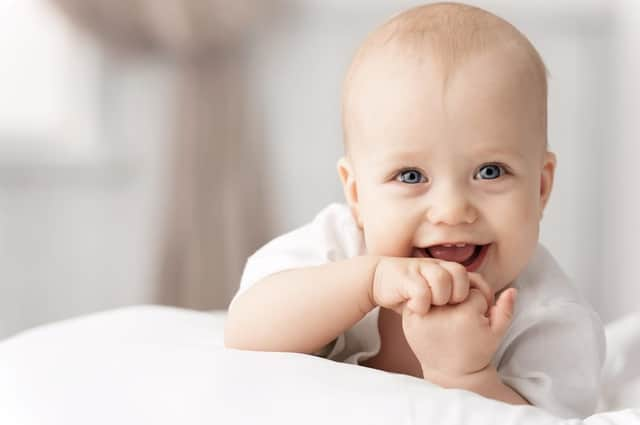Babies breathe in a dust storm kicked up as they crawl


When babies crawl they "kick up" a dust storm of dirt, skin cells, bacteria, pollen, and fungal spores which they breathe in, a study found
And because they are so close to the floor they inhale four times as much as when an adult walks across the same surface, with carpets and rugs they worst for the "dust smog."
Advertisement
Hide AdAdvertisement
Hide AdBut while this cloud of dust and dirt may sound alarming, experts reassured parents it was not necessarily a bad thing as it could help infants build up defences against asthma and allergies.
Assistant Professor of Civil Engineering Brandon Boor of Purdue University in Indiana said: "We are interested in the biological material an infant inhales, especially during their first year of life when they are crawling.
"Many studies have shown that inhalation exposure to microbes and allergen-carrying particles in that portion of life plays a significant role in both the development of, and protection from, asthma and allergic diseases.
"There are studies that have shown that being exposed to a high diversity and concentration of biological materials may reduce the prevalence of asthma and allergies later in life."
Crawling chaos
Advertisement
Hide AdAdvertisement
Hide AdWhile previous studies have looked at how much dirt and biological material is kicked up and resuspended into the air when an adult walks indoors, the study is the first study to look at what happens with infants and their unique forms of locomotion.
Babies are the only mammals that cannot get up and walk straight after birth and they take months before they can take a few wobbly steps like a newborn elephant, giraffe or horse.
As babies roll, slide and crawl on the floor, their movements stir up more particulates into the air, and their mouths and nostrils are much closer to the floor where the concentrations are greater.
This is countered somewhat by the fact that babies tend to move in much shorter bursts of activity than do older children or adults.
Advertisement
Hide AdAdvertisement
Hide AdTo explore the smog kicked up, the study published in the journal Environmental Science & Technology built a robotic crawling baby.
The robot was then tested crawling on actual carpet samples they had removed from homes and researchers measured and analysed the particulates in the breathing zone.Prof Boor said: "We used state-of-the-art aerosol instrumentation to track the biological particles floating in the air around the infant in real-time, second by second.
"The instrument uses lasers to cause biological material to fluoresce.
"Most bacterial cells, fungal spores, and pollen particles are fluorescent, so they can be reliably distinguished from non-biological material in the air.
Advertisement
Hide AdAdvertisement
Hide Ad"We also worked with a microbiology group at Finland's National Institute for Health and Welfare, which conducted DNA-based analysis of the microbes we collected onto filters."Cloud concenration
It was found a concentrated cloud of resuspended particles formed around the robot and concentrations around them can be as much as 20 times greater than the levels of material higher in the room.
Moreover infants' bodies aren't as good at blocking this dust storm.
Prof Boor said: "For an adult, a significant portion of the biological particles are removed in the upper respiratory system, in the nostrils and throat.
Advertisement
Hide AdAdvertisement
Hide Ad"But for very young children, they more often breathe through their mouths, and a significant fraction is deposited in the lower airways - the tracheobronchial and pulmonary regions.
"The particles make it to the deepest regions of their lungs."
Yet counterintuitively this may be just what nature intended.
In the late 1980s, British epidemiologist David Strachan was the first to propose the "hygiene hypothesis," which says that too clean of an environment may suppress the development of the immune system.
Advertisement
Hide AdAdvertisement
Hide AdAllergists also sometimes refer to this as "the farming effect."
Prof Boor said: "Exposure to certain bacterial and fungal species can result in the development of asthma, but numerous studies have shown that when an infant is exposed to a very high diversity of microbes, at a high concentration, they can have a lower rate of asthma later in life.
"Such exposures act to stimulate and challenge your immune system."
He notes as most infants in western societies spend nearly all of their time indoors, where indoor dust resuspension may contribute significantly to their respiratory encounters with biological material.
Advertisement
Hide AdAdvertisement
Hide AdHe concluded: "While our research established new methods for infant microbial exposure assessment, much remains to be discovered
"I hope to continue to work with microbiologists and immunologists to better understand the role of indoor air microbes and allergens on early-childhood health."